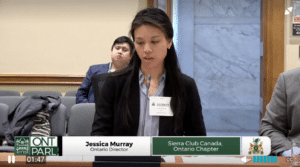Using Bill 69 to gut Environmental Assessment Act is destructive; not “reducing inefficiencies

By Jessica Murray on Bill 69, Sierra Club Ontario Director, Sierra Club Canada Foundation
The following was presented to Ontario Provincial Standing Committee on Heritage, Infrastructure, and Cultural Policy by Sierra Club Ontario Director Jessica Murray:
Class Environmental Assessments (EAs) are a fast-track for environmental assessments where projects are deemed to be somewhat routine and with minimal impact to the environment. However, there is much well-deserved criticism for class EAs used in real practice: higher impact environmental projects have been slipped under class EAs (Lindgren and Dunn, 296), and they are essentially pre-approved projects that are never rejected (Lindgren and Dunn, 284). The amendment in question, Bill 69 under The Reducing Inefficiencies Act would give the Minister of Environment the discretion to effectively silence public opinion on class EAs by waiving the 30 day period where the Minister would review public submissions and consider a “bump-up” to a full individual EA.
One would hope that individual EAs, which are a step-up from class EAs, would provide more protection, and act as a safeguard considering the token protection class EAs provide. However, as was the case in the Darlington Nuclear Power Plant EA, individual EAs are themselves also problematic. Within the 390 page document for the Darlington Nuclear Environmental Risk Assessment, much was documented in risks and potential damage to endangered and threatened wildlife (New Darlington Nuclear Power Plant Project: Terrestrial Environment and Aquatic Environment), however not one recommendation to mitigate or prevent harm was stated (EcoMetrix Incorporated, 326).
Essentially, individual EAs themselves are inadequate at meeting the true intention and goal for environmental assessment, which is supposed to be a primary means through which we achieve sustainable development and public participation in environmental decisions. In effect, Ontario has no true process to effectively protect its environment via impact assessments.
Furthermore, this amendment should be taken in the context that the Premier has already begun to build out the Greater Toronto Area in a way that increases urban sprawl, fragments sensitive habitats, and builds into Ontario’s protected Greenbelt. Passing this amendment would only increase the speed at which development can recklessly occur, and does not consider the cumulative effects that a high volume of class EAs has on our environment (Lindgren and Dunn, 297).
Our Premier often cites the need for housing as a reason to sprawl into protected areas. However, building in this manner is entirely unnecessary to meet the goals of the province or the Canada Mortgage and Housing Corporation (CMHC). Ontario has hundreds of square kilometers of land within urban boundaries that are underdeveloped and zoned exclusively for very low density. Rezoning for medium to high density within the large urban boundaries of the Greater Golden Horseshoe and Ottawa would be more than adequate to meet the metrics put out by the province and CMHC. Ending exclusionary zoning and focusing on infill with the missing middle (Toronto Region Board of Trade, and World Trade Centre Toronto) would both help the province meet its housing goals, reduce red tape time lags (as developing in urban areas are less likely to require individual EAs), and support Canada’s goals towards affordable housing while restricting the damage to climate change and biodiversity.
Urban sprawl directly harms biodiversity, as wildlife need unfragmented land to travel and breed upon, otherwise they become isolated, inbreed, and die off (Syed et al.). Without biodiversity, we lose medicine, food, water purification, weather regulation (Ontario Parks), as well as culture. We also expose ourselves to higher risks of another zoonotic outbreak such as covid-19 (ClientEarth).
In sum, this amendment in question is one cog in a larger machine that does little to protect the environment, is offensive to the true intention of the environmental assessment process, infringes on the democratic rights of the public to have a fair process in how land is developed, and pushes us further away from Canada’s urgent climate change and biodiversity goals.
We have three main questions for the Standing Committee
- What is the main intention of this amendment ? Has the government actually assessed to see if its intended outcomes will occur?
- Why has the government chosen to eliminate the part of the EA process that gives the public a window into EAs?
- What does the government believe will actually change with the proposed amendment?
We hope this message has been heard and will be acted upon accordingly with the care it deserves.
Find out more about our work on environmental issues like Bill 69 Ontario
- Take action to protect nature.
- Sign up for email updates on our homepage.
- Sierra Club Canada’s work to protect biodiversity, nature, and endangered species.
- Find out more about Sierra Club Canada’s Ontario Chapter.
Resources Cited:
JOURNAL ARTICLE
Lindgren, Richard D., and Burgandy Dunn. “Assessment in Ontario: Rhetoric vs. Reality.” he Journal of Environmental Law and Practice, 2010.
ENVIRONMENTAL ASSESSMENT REPORT
EcoMetrix Incorporated. Darlington Nuclear Environmental Risk Assessment. 2017.
“Why is biodiversity important?” Ontario Parks, 18 April 2022.
“What is biodiversity and why is it important?” ClientEarth, 28 June 2021.
